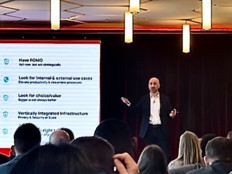Focus Digital Transformation Projects with Goals That Deliver Value
Frustration and change fatigue often stem from not being able to see the value of a new way of working. To create early momentum, leaders should design pilot programs with each team’s key priorities in mind. This approach will give teams a better understanding of what a particular new digital tool could be used for, how they can benefit and why it will contribute to the team’s role in driving business outcomes.
Adapting team and department processes around specific use cases presents a direct opportunity to learn in an interactive and relevant way, rather than attending an all-day workshop where the entire system functionality is detailed in theoretical or hypothetical scenarios.
EXPLORE: Find out how digital transformation helps you achieve your business goals.
Take the time to create learning opportunities that don’t interrupt or burden employees. This might mean offering “lunch and learns” that provide hands-on instruction as well as a chance for colleagues to chat about the new technology over a meal. It could also mean setting up a friendly internal competition to encourage experimentation and innovation with digital tools.
A modular approach focused on teaching individuals how to use technology in a way that is accessible — and not limited to trainings — helps explicitly connect purpose and outcomes, further engaging employees.
Show Employees How Mastering New Tools Can Improve Their Lives
As more pilot programs are introduced and additional tech functionality is adopted, “digital trailblazers” can work across teams to continue breaking down silos and making progress toward the goal. This empowers leaders and employees of all levels to take what they’ve been learning and build on it, ultimately scaling to the desired value with significantly less risk and a better ROI than through a massive one-shot overhaul.
Rather than overwhelming your employees with the change requirements for a large-scale, complex transformation, consistently building on smaller-scale initiatives can lead them to embrace the change and create better outcomes by adjusting and adapting as needed. Encourage everyone to see what they can do with new technology and how they will make their own jobs easier as they master it.
RELATED: Learn why digital transformation hinges on people as much as technology.
Some transformations don’t lend themselves to this approach. But in most cases, a microtransformation method is likely to yield better results, especially in a more dynamic, complex and volatile context.
Worker burnout can make launching a large-scale digital transformation daunting. But when the transformation is designed as a series of modular initiatives that build on each other and incorporate active learning, it helps balance existing work priorities with the transformative change that will help the organization grow.
This article is part of BizTech's AgilITy blog series. Please join the discussion on X (formerly Twitter).













